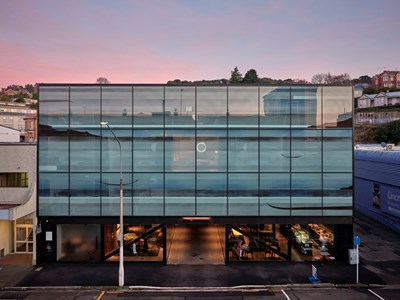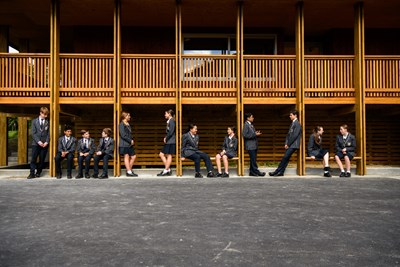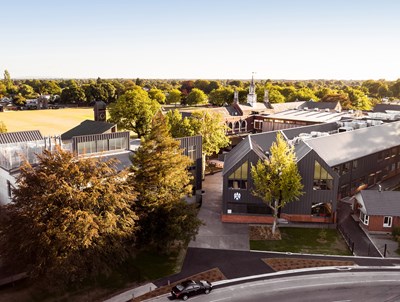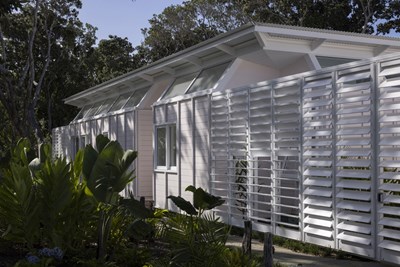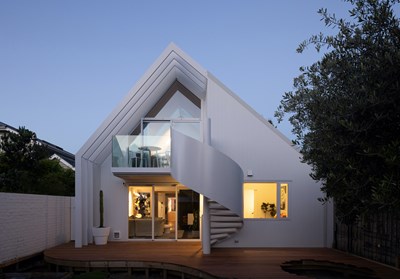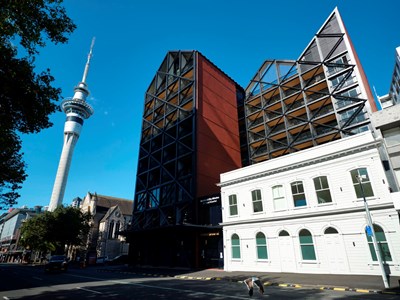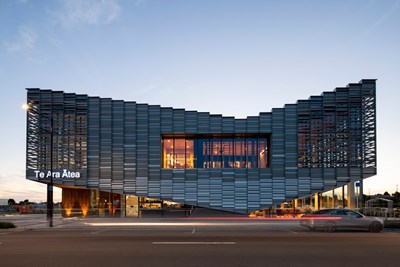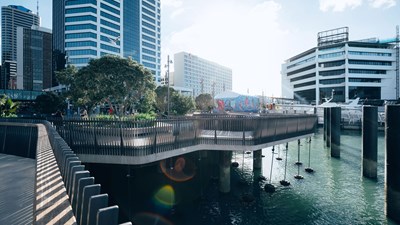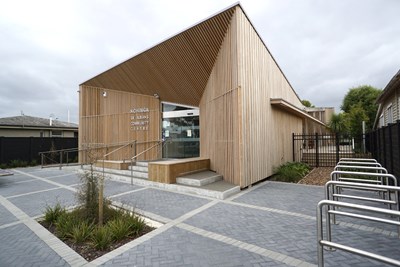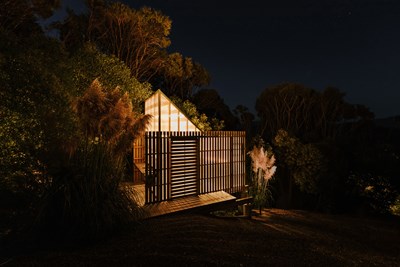The Te Kāhui Whaihanga New Zealand Institute of Architects celebrated the best of the best at its annual awards ceremony at Christchurch Town Hall tonight, awarding 29 winners — in 11 categories and four exceptional Named Awards — from a shortlist of 47 inspiring projects.
Te Rau Karamu Marae, the new cultural heart of Massey University campus in Wellington, designed by Athfield Architects in association with Te Kāhui Toi, received two awards in the Education and Interior Architecture categories. Judges described the project as delivering an enriching cultural outcome, with subtle use of light and shade to enhance the storytelling of the beautiful space.
Stevens Lawson Architects with Jack McKinney in association of Tāmaki Makaurau Auckland received two awards in the Public Architecture category: for Te Puna at Auckland Zoo, a deceptively simple building that resolves modern zoological needs while providing visitors with an observation platform; and for HomeGround — Auckland City Mission Te Tāpui Atawhai, for its sensitive heritage restoration. HomeGround — Auckland City Mission Te Tāpui Atawhai was also a winner in the Housing — Multi Unit category, alongside 132 Halsey by Athfield Architects and Party Wall by Patchwork Architecture.
Ōtautahi Christchurch boasted five winners, including Kohinga St Albans Community Centre, a net-zero, cradle-to-grave, embodied-energy building designed by Christchurch City Council; Te Ara Ātea by Warren and Mahoney Architects, a multipurpose building that offers a library, exhibition and performance space for the community; and First Church of Christ Scientist (1991), an enduring piece of post-modern New Zealand architecture by Warren and Mahoney Architects, which came close to demolition, but has been repaired and restored; Christchurch Boys’ High School Caddick Caldwell Blocks by Athfield Architects; and Beach Barn, a light-filled home by C Nott Architects and Alex Fulton Design in association.
Beach Barn was joined in the Housing - Alterations and Additions category by two winners from Tāmaki Makaurau Auckland; Town House, a pair of Edwardian townhouses carefully restored and cleverly reconfigured by Guy Tarrant Architects; and Under Ivy, a sophisticated 1890s villa restoration by Jack McKinney Architects.
Judges praised Studio of Pacific Architecture for its careful management of the Massey University Refectory project, a 1930s building that needed seismic and accessibility consideration. It was crowned the sole winner of the Heritage category.
Planning and Urban Design awards went to Te Wānanga by Isthmus, Mana Whenua and Downtown Programme in association, a new public space integrating and embedding elements of Māori design in Tāmaki Makaurau Auckland; and Ōmarukaikuru by Isthmus, a gathering space in Te Whanganui-a-Tara Wellington, for people to pause and connect with the coast.
Footsteps Preschool by Parsonson Architects and Whitby Collegiate Classroom Pavilion by Andrew Sexton Architecture were both winners in the Education category, noted for their careful and detailed designs that enhance places of learning and creativity.
Awards in the Small Project Architecture category went to: Nightlight in Akaroa by Coll Architecture | Fabric, a beautifully crafted shed tightly packed with a kitchen, bathroom and workshop; and The Cabin by Johnstone Callaghan Architects, a minimalist camping inspired space that beautifully connects bush and water.
Winners in the Commercial category included the Ōpuke Thermal Pools and Spa, an impressive tourist destination in Methven, designed by Sheppard & Rout Architects; Brandon House, a refurbished building extended by three floors and wrapped with a taut skin of bronze glazing, by Studio of Pacific Architecture; and EBB-DUNEDIN by Gary Todd Architecture, a hotel that activates at street level through a porous design and an artwork that wraps the building.
Awards for Housing went to Waterhouse Family Home by Bull O’Sullivan Architecture; Mawhitipana House by MacKay Curtis; Crinkle Cut by Pac Studio and Steven Lloyd Architecture, Waimataruru by Pac Studio and Kristina Pickford Design in association; and Kahutara House by Patchwork Architecture.
An additional four Named Awards were presented to outstanding projects for excellence in architecture. EBB Dunedin received the Sir Miles Warren Award for Commercial Architecture; Christchurch Boys’ High School: Caddick Caldwell Blocks was awarded the Ted McCoy Award for Education; Party Wall won the Sir Ian Athfield Award for Housing; and HomeGround — Auckland City Mission Te Tāpui Atawhai was awarded the John Scott Award for Public Architecture.
The inaugural John Sutherland Practice Award was awarded to Architecture+Women NZ – the leading voice for equity in architecture in Aotearoa. This new award celebrates and acknowledges the influence and impact of individuals, groups or collectives on architecture and the built environment, of which Architecture+Women NZ has made a profound contribution since its inception in 2011.
Andrew Irving, partner of Irving Smith Architects and Te Kāhui Whaihanga jury convenor, says the jury were impressed by the quality and calibre of the shortlisted projects.
“We had a great whirlwind tour of New Zealand, assessing a series of great buildings, with talk about little else. We covered 47 projects in 12 towns and cities over 10 days,” Andrew says.
“On behalf of the national jury, I extend our thanks to the clients who opened their homes, schools, hotels, and small projects to our gaze. All of the clients we met were tremendous advocates for architecture and committed to the process. We appreciate the warm welcome we received at each project.”
Full list of 2022 New Zealand Architecture Awards winners
Commercial Architecture
• EBB-DUNEDIN, Gary Todd Architecture, Dunedin
• Ōpuke Thermal Pools and Spa, Sheppard & Rout Architects, Methven
• Brandon House, Studio of Pacific Architecture, Wellington
Education
• Whitby Collegiate Classroom Pavilion, Andrew Sexton Architecture, Wellington
• Te Rau Karamu Marae, Athfield Architects and Te Kāhui Toi, Massey University in association, Wellington
• Christchurch Boys’ High School: Caddick Caldwell Blocks, Athfield Architects, Christchurch
• Footsteps Preschool, Parsonson Architects, Palmerston North
Enduring Architecture
• Church of Christ Scientist (1991), Warren and Mahoney Architects, Christchurch
Heritage
• Massey University Refectory, Studio of Pacific Architecture, Palmerston North
Housing
• Waterhouse Family Home, Bull O'Sullivan Architecture, Cambridge
• Mawhitipana House, MacKay Curtis, Auckland
• Crinkle Cut by Pac Studio and Steven Lloyd Architecture, Auckland
• Waimataruru by Pac Studio and Kristina Pickford Design in association, Coromandel
• Kahutara House, Patchwork Architecture, Wairarapa
Housing — Alterations and Additions
• Beach Barn, C Nott Architects and Alex Fulton Design in association, Sumner
• Town House, Guy Tarrant Architects, Auckland
• Under Ivy, Jack McKinney Architects, Auckland
Housing — Multi Unit
• 132 Halsey, Athfield Architects, Auckland
• Party Wall, Patchwork Architecture, Wellington
• HomeGround - Auckland City Mission Te Tāpui Atawhai, Stevens Lawson Architects, Auckland
Interior Architecture
• Te Rau Karamu Marae, Athfield Architects and Te Kāhui Toi, Massey University in association, Wellington
• Te Ara Ātea, Warren and Mahoney Architects, Rolleston
Planning & Urban Design
• Ōmarukaikuru, Isthmus, Wellington
• Te Wānanga, Isthmus, Mana Whenua and Downtown Programme in association, Auckland
Public Architecture
• Kohinga St Albans Community Centre, Christchurch City Council, Christchurch
• HomeGround - Auckland City Mission Te Tāpui Atawhai, Stevens Lawson Architects, Auckland
• Te Puna at Auckland Zoo, Stevens Lawson Architects and Jack McKinney Architects in association, Auckland
Small Project Architecture
• Nightlight, Coll Architecture | Fabric, Akaroa
• The Cabin, Johnstone Callaghan Architects, Abel Tasman National Park
Named Awards
• EBB-DUNEDIN — Sir Miles Warren Award for Commercial Architecture
• Christchurch Boys' High School: Caddick Caldwell Blocks — Ted McCoy Award for Education
• Party Wall — Sir Ian Athfield Award for Housing
• HomeGround — Auckland City Mission Te Tāpui Atawhai — John Scott Award for Public Architecture
John Sutherland Practice Award
• Architecture+Women NZ
About Te Kāhui Whaihanga New Zealand Institute of Architects:
Te Kāhui Whaihanga New Zealand Institute of Architects is a membership-based professional organisation that represents more than 90 percent of registered architects in Aotearoa and promotes architecture across the country.
First established in 1905, the Institute currently has around 5000 members. Approximately 50 percent are registered architects working in New Zealand, with the balance of membership made up of New Zealand architects working overseas, architectural graduates, architecture students, teachers of architecture and retired architects.
About the awards:
The Institute has operated an awards programme, in some form, since 1927. The aim of the New Zealand Architecture Awards programme is to recognise excellent achievement and to encourage architects to produce high-quality work that benefits their clients and their communities. At the national level, the awards programme is expected to showcase projects.
The Awards jurors:
• Andrew Irving, (convenor) Partner, Irving Smith Architects, Nelson
• Mel Bright, Director of Studio Bright, Melbourne
• Ana O'Connell, Director, Lovell & O'Connell Architects, Wellington
• Craig Moller, Director, Moller Architects, Auckland




